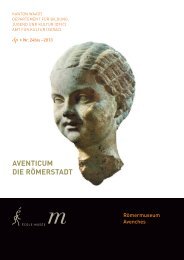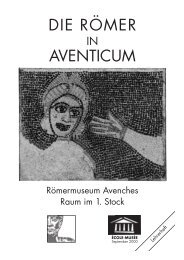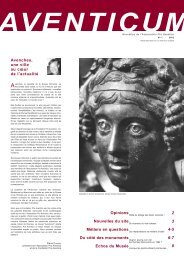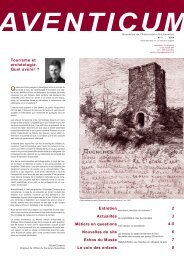Avenches – Roman Museum – Permanent Exhibition
Avenches – Roman Museum – Permanent Exhibition
Avenches – Roman Museum – Permanent Exhibition
Create successful ePaper yourself
Turn your PDF publications into a flip-book with our unique Google optimized e-Paper software.
First Floor Religion<br />
<strong>Roman</strong> Religion<br />
« Mars Gradivus, father ... my mother country and its citizens, ... glorious warrior; as he was<br />
rightly so ordered (?) in his dream, Sextus Tetricius offers you this donation »<br />
Late 2nd or early 3rd century AD.<br />
Catalogue of inscriptions: no. 24.<br />
14. Jasper intaglio. Head of Mercury and two letters: TI, standing for Tiberius?<br />
Early 1st century AD.<br />
15. Nicolo intaglio. Satyr holding a flute in his left hand and a crook (pedum) in his right,<br />
and wearing a fawn skin (nebris). There is a star at the bottom on the right.<br />
Early 1st century AD.<br />
16. Garnet intaglio. Dancer in the retinue of Bacchus. In his right hand, he is holding a<br />
cantharos and he has a fawn skin (nebris) draped over his arm. With his left hand, he is<br />
waving a staff embellished with ribbons (thyrsus). A tipped over wine crater is lying on the<br />
floor on the right-hand side. Early 1st century AD.<br />
17. Cornelian intaglio. Minerva holding a lance in her left hand and the sheath of a sword<br />
in her right. Her shield is placed on the ground in front of her. 2nd century AD.<br />
18. Bronze owl; bird associated with Minerva.<br />
19. Bone pin with bust of Minerva.<br />
20-22. Three bronze coins with Minerva depictions. 1st century AD.<br />
23. Apollo. Bronze statuette. 2nd century AD.<br />
Statue of the Goddess Minerva (1)<br />
Head, right forearm, feet and fingers of the left hand; marble. Original height of statue:<br />
2.8 m.<br />
So-called acrolith statue. Only the visible parts of the statue are sculpted in marble.<br />
Remnants of wood in the groove at the neck and an iron hook on the forearm of the<br />
statue indicate that the rest of the body was probably made of wood and was hidden<br />
under a dress made of cloth. Minerva is wearing armour decorated with a marble head of<br />
Medusa. The helmet on Minerva’s head bears a face with closed eyes.<br />
The fragments of the statue had been carefully buried in a so-called favissa, a type of<br />
ritual ditch inside a building right beside the forum. This building might have been a<br />
library or a meetinghouse. As the goddess of wisdom, of the arts and of science, Minerva<br />
was often placed in that kind of location. 2nd century AD?<br />
The two mosaic glass discs, found nearby, may have been used to decorate a wooden<br />
chest.<br />
Display case 21<br />
Fragment of sitting statuette, limestone. 2nd <strong>–</strong> 3rd centuries AD.<br />
This representation of Jupiter resembles the cult statue of Jupiter Optimus Maximus,<br />
which stood in the temple of the Capitol in Rome.<br />
This statuette may have adorned a column similar to the one found in Mayence (see<br />
drawing on the other side). Should this assumption be correct, the original height of the<br />
column would have been 3.9 metres approximately.<br />
1<br />
40<br />
First Floor<br />
20<br />
21








